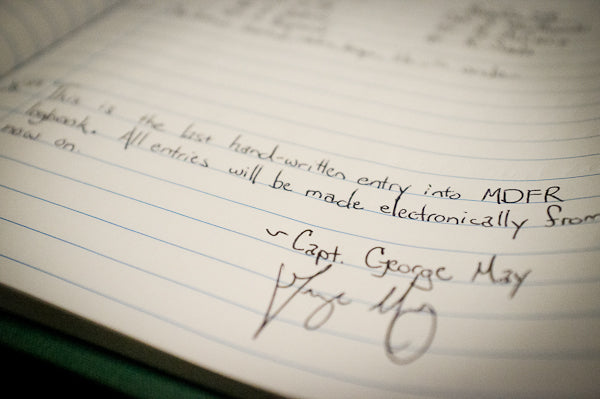Hook and Irons
The Damn Few May 09 2018, 3 Comments
The following is a guest blog by Capt. Mike Yetter, currently a USAR member, he is a training Capt with MDFR and former Captain of 'The Meat Grinder,' Aerial 29.
“The man on top of the mountain didn’t fall there.”
– Unknown
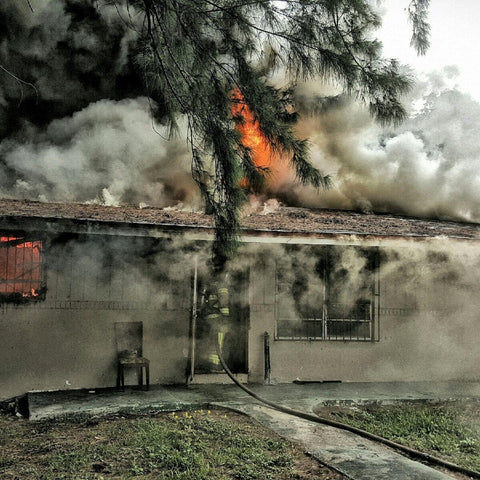
“Here’s to us and those like us. The Few. . .The Damn Few.”
The above lines are paraphrased, but in its entirety were made famous in the Book “Damn Few” by US Navy SEAL Rorke Denver and the movie in which he was also a part of, “Act of Valor." As with many inspirations that originate from the military, the concept of the few who make the difference resonates so true within the fire service.
Recently, it's become apparent to me that there are only a few who give a damn about the ethos, logos and pathos in cultivating true Firemanship. It seems there are too damn few people who earn their paycheck compared to those that collect them. It appears more people are willing to get this job and damn few of them care enough to be good at it. There are too many recliners that shows signs of wear and tear when damn few are wearing out their gear on the training grounds.

The “Damn Few” are just that--the minority. If you could group people into categories based on their work ethic, these would probably be the following categories as I observe them:
20% would consist of the “Aggressively Disengaged.” These are the people who arrive in body (not necessarily in spirit) just to collect a paycheck. They are barely average, yet complain when no one goes above and beyond to meet their needs. This doesn’t make them bad people, this just makes them useless. They are a liability to the department in terms of their lack of KSA’s and their potential influence to others.

60% are the “Average/ Status Quo”. As the group that represents the majority, these individuals are neither good or bad. They hang in the proverbial purgatory. Many who occupy this position have the capacity to rise above the status quo to either accomplish and be more, or sink to the level of the bottom feeders. The only thing that separates the direction they go is the influence that guides them. These individuals have a choice. They are inclined by nature to be receptive to the influence that suits them.
Those categorized above are usually referred to as “Nice” when someone inquires about them. Be careful! If someone asks about a firefighter and the response is a shoulder shrug that coincides with an answer of, “He/She is a nice person…” This is the tell, or politically correct way of implying that other than being a pleasant person, they typically don’t provide any benefit other than companionship.
20% are the “Damn Few." This designation is not self-imposed. These are the individuals who were either born to operate at a higher level or were so receptive to guidance it almost feels natural. These individuals are stubborn, somewhat idealistic, and have a strong disdain for anything less than the pursuit of perfection. Typically viewed as being “righteous”, they are seen as overachievers by their peers. Subordinates and supervisors (unless they are like minded) honestly don’t much care for them. However, when the impossible is presented because the many can’t accomplish it, it’s "The Few" that get it done.

These thoughts transcribed are not done so from a pedestal. They are not intended to create inflated egos. These are merely observations from the trenches in admiration to the specific rare breed of individual who are rarely recognized for their dedication.
Tonight, I raise my pint to you. . .The Damn Few.
Do you have a friend or coworker that you consider to be one of The Damn Few? Write their name in the comment section below.
-->The Flynn Effect April 22 2013, 5 Comments

Much has been written in the journals and periodicals about the new generation of firefighters and how they are different from previous generations--not as worthy, not as smart, and more self-centered. We bemoan how they 'should be' and don't spend enough time getting them where they need to be. Certainly, at MDFR we have seen our share of questionable employees pass through our house. But I won't categorize the younger firefighters by their worst examples as each generation has its share of 'less than motivated' employees. Instead, I find most of the probies to be intelligent in ways that often surprise and sometimes humble me. And I have no doubts that tomorrows firefighters will be smarter than I am. But I do occasionally find them to be lacking and disappointing in ways that I've come to understand is a result of today's society.
But first let's talk about how they're smarter:
James Flynn is a researcher from New Zealand who discovered and coined The Flynn Effect. The Flynn effect is an explanation for the steady rise in IQ scores from generation to generation. He contends that the rise in IQ scores proves that this generation is more intelligent than the generation before and so on and so on. The effect is caused by each generation growing up with the increased benefit of looking at the world with 'post-scientific' spectacles. We classify, we analyze and we think more abstractly. In general, according to Flynn the rise in IQ scores is largely due to increased reasoning skills. Those increased reasoning skills allow us to solve more complicated problems than the previous generations. Additionally, more time is spent on mental pursuits than ever before. Proof is in the internet, the video games, the tv, the fantasy leagues and so forth.

And I can buy all of this. I believe James Flynn and hope he is right. I want my son to be smarter than me and I want him to benefit from the research and work of my generation. In the station, what I observe from my young guys allows me to generally agree with the Flynn Effect although as a good Captain, I will never admit that any of them are smarter than I was at their age. I can say I honestly spend very little time explaining the ideas of fire growth or the incident command system. These concepts and the importance of understanding them seem clear to most of the young guys. In fact, these are the things that most of the young guys cling to and quickly understand. I can also say that most of them can reason through tactics and strategy scenarios as well as most of our experienced chiefs. These are the areas that truly impress me.
The problem in the fire service right now is something I'll call the 'Y Gap'. I call it the 'Y Gap' because this is the generation that seems to suffer the most from this problem. The 'Y Gap' is, the distance between intelligence and physical skills. If the distance is short, you probably have a good firefighter on your truck. The good firefighter is intelligent, shows good foresight and has good hands-on skills. They can swing an axe, work a saw and don't buckle with the fear of heights. Additionally, they know when to put these skills to use. The 'gap' that I see is an increase in intelligence and a decrease in physical ability. Many of our recruits have never mowed a lawn, changed their own oil, worked a chainsaw, or swung a hammer. Instead, they pay someone to mow their lawn, change their oil and if they need to nail something they use a nail gun instead. We receive these guys without the base knowledge of mechanics and form used to do so many things on the fire ground. This is the area that most of the new guys suffer and the area that the academies do not focus on. So we get guys who can tell us the phases of fire, but have no idea what a two stroke motor is.
The answer is to go back to the beginning--take your probie to the saws and teach them why it's a two stroke engine and how it works. Then, let them cut scrap metal until they look like their not scared of the saw anymore. After that, challenge them to make cuts of increasing skill and so on until they know the saw well enough to cut any material in any fashion you ask. None of this takes intelligence. None of it takes reasoning or analytical skills. What it takes is form and practice and with enough of it you gain muscle memory--and with muscle memory you gain skill. And that is why I will always respect the old guys like my dad, who, while driving to a fire years ago felt the truck die to an idle at his feet. He popped the cab, saw that the throttle spring was gone and replaced it with a piece of the elastic chinstrap on his helmet. He made it to the fire (was last in) but he made it. And he made it there because he has common sense and grew up working on cars and performing a lifetime worth of manual labor.
So, if you are one of these new guys, I suggest you start changing your oil, mowing your own lawn, digging out your own stumps even though your intelligence and reasoning skills might tell you that there is an easier way to get it done. You never know, it just might save your life one day.
-George

Our Lady of Angels Fire December 01 2012, 4 Comments
Today marks the 54th anniversary of Our Lady of Angels Fire that devastated so many lives and marked one of the most tragic fires in American History. The fire occurred at Our Lady of Angels School on the west side of Chicago and killed 92 children and 3 nuns. Here is an excerpt from a previous Chicago Tribune story about the fire:
"Max Stachura stood outside the burning building, begging his little
boy, Mark, 9, to jump into his arms. Children were falling all about the
father and he caught or stopped the fall of 12 of them. But little Mark
was too frightened or he didn't understand his father. Mark didn't
jump."
Fifty years later, Mark's mother has the day in crisp focus, and adds a missing detail.
As Mark stood at that second-floor window, fire to his back, he held a
small statue in his hand and waved it proudly through the black smoke,
hoping his father would notice. Mark had won the statue that day a
figure of an infant Jesus for being first to answer a quiz question.

The fire began at the foot of a stairwell in the basement of the school about an hour before school was scheduled to let out for the day. The fire which started in a trash barrel went unnoticed for 10-20 minutes filling the stairwell and the 2nd floor (which did not have a fire door) with smoke. Fire department units arrived within four minutes of being called, but
by then the fire had been smoldering unchecked for possibly 40 minutes.
It was now fully out of control. The fire department was also hampered
because they had been incorrectly directed to the rectory address around
the corner on West Iowa Street and lost valuable minutes repositioning fire trucks and hose lines. Additional firefighting equipment was summoned
rapidly, but by then it was already too late for most that were trapped on the second floor. Stories from the firemen and victims from that day are truly horrific.
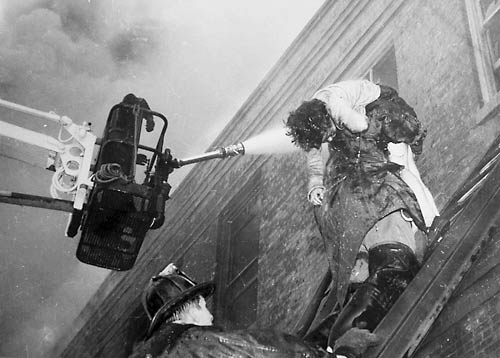

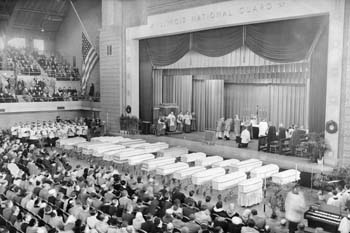
Our Lady of Angels fire brought sweeping changes in school fire safety regulations which were enacted
nationwide, including mandatory sprinkler systems, fire doors, and requirements for specific building materials for the construction of new schools. Some 16,500 older school buildings in the United States were
brought up to code within a year of the incident. We've attached a short docu-film about the fire and if you're interested in reading more about the fire, its cause and the investigation afterward, you can click here.
Hugh Halligan's Masterpiece Revisited November 28 2012, 9 Comments
When we created Hook & Irons Co. we came up with the Signature Line as way to pay homage to the parts of the fire service that are historically significant-- the parts of the fire service that so many of us feel passionately about. We brainstormed over so many things during those first days, but always, and without question, we were certain that we wanted to create a shirt honoring every fireman's favorite tool, the Halligan bar.

Hugh Halligan on right
Hugh Halligan is an icon of the fire service. With FDNY, he rose to the rank of Deputy Chief and is remembered as a 'fireman's fireman' working on many of the busiest companies in the city. But, he is known best for the tool he invented that is still carried on nearly every fire truck in America. While today's versions may have been refined a bit, and are now built by different manufacturers, they are very nearly the same exact tool that Halligan invented in the 1940's.
The original Halligan tool was made of cross-drop forged from one piece of No. 4140 (high carbon content) steel, and weighed 8 ½ lbs. This was a great improvement in strength and weight over its predecessors, The Claw and Kelly tool. The standard bar was approximately 30” in length, with a 15/16” shaft shaped into a hexagon for grip. The fork was a minimum of 6” long tapered into two well beveled tines. Spacing between the tines allows for a gas valve to be shut off. And stamped into the steel of the forks of the original Halligan tool was Hugh's signature and the letters AM + DG. Chief Halligan was a very religious man and it is widely believed the letters stood for the Latin phrase , Ad Majorem Dei Gloriam or “for the greater glory of God.” This phrase was a favorite of St. Ignatius of Loyola, founder of the Society of Jesus. Pope John Paul II routinely used it in his writings. He would print AMDG in the top left of every page he wrote. The + sign is widely believed to represent a cross.

When creating the shirt, it was important to us to include these elements into the design. We used the original advertisements as inspiration and we picked colors that we thought were as hard-looking as the drop-forged steel of the Halligan tool. The typography is chosen and inspired from the ad, as well as the slogan, "Yes! It is an Ugly Bar." The ribbon at the bottom of the shirt (also taken from the ad) represents the Boston Fire Department who was the first to recognize the genius of the tool and put one on every single truck in Boston.


The genius of the Halligan tool becomes apparent in the hands of a skilled operator and when properly used – provide protection to the arms, hands, and body of the holder during forcible entry operations. Pound for pound, it is the best tool on any rig and paired with a flat-headed axe, the Irons are a Truckie's best friend.
To this day, there are fire companies who still carry and use an original Halligan tool on their rigs. Tools that are nearly 70 years old and still working to this day. Yes, it is an UGLY tool! and yes we are very proud to offer Hook & Irons second Signature Tee--The Halligan Tee.

*All the research for this blog and the t-shirt were done on-line. Information was gathered from a wealth of stories and articles, conversations and forum posts. Thanks to Rob Fisher, Irons and Ladders, and Hugh Halligan's own article entitled, "The Halligan Tool" which appeared in a 1950 issue of WNYF for which most of this research was taken.
Close the Book October 11 2012, 10 Comments
This week, my department released a very short, simple memo. It stated that on Monday October 8, 2012 Miami-Dade Fire Rescue would no longer maintain a hand written logbook. Perfunctory and to the point, the e-mail was sent to every firefighter in our department.
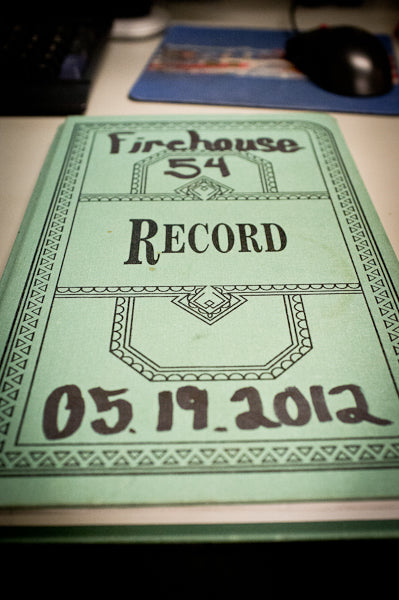
There wasn't a pause, a moment of silence, a last alarm, or even a mention of the tradition we killed in the name of efficiency. No one said a eulogy and no one rang a bell for the thousands of officers that had carefully documented everything that had happened on their watch at their station on any given day in Dade County. To think about the millions of calls our department has run in almost a hundred years is one thing. To see the volumes of logbooks that document every one of them is another.
Why was I so bothered by this change? Every other officer I talked to seemed thankful that this extra bit of work was being lifted from our shoulders. Don't get me wrong, at three o'clock in the morning there is no higher form of drudgery than sitting down and documenting some call that was anything but an emergency. Why, after five day, does this change still bother me? This was something that I had a hard time putting my head around. I'm certainly not a technology hater or a doomsday prepper. I have my iphone in my pocket. I'm on Facebook. I love having the TIC at my side going into a fire. And I'm sure the department has all of our documents secured on servers in fireproof rooms and virtual iclouds. Then it hit me.
Those logbooks--those documents written in so many different handwriting styles, are the only substantive evidence of the daily work we do. Those books are the only thing that you can pick up, feel, read, and see what that day--any day cost us. You can see it in the chicken scratch of tired officers or the careful letters of men who are not used to writing much more than their name. But most of all, you could walk in before your tour, run your finger down the column of calls and see if your brothers had a fire, a rough night, or if the gods were kind and let them sleep.
So this blog is not so much about blasting technology. It is more a warning to consider the things you leave behind in the name of efficiency.

What was lost today? Today I lost that moment in the morning when I sit with my coffee and write the names of each member of my company--that moment where I sit and consider their strengths and weaknesses and how I will use them in different situations. Sure I will still do this. I'll just have to find another way. And for me, writing these names was a reminder to myself, a contract that I am beholden to that states that I'm responsible for the safety of each firefighter at my station. If you don't believe me you can look for yourself and see it written in black and white on the page.
There isn't a blinking screen in the world that can provide that same feeling.
